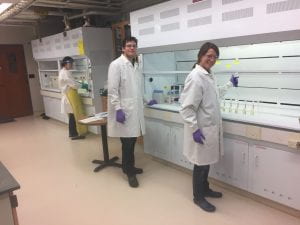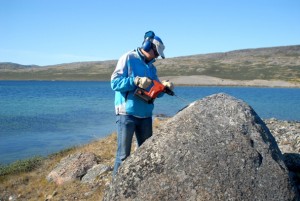Quaternary Geology Laboratories
The Quaternary Geology Laboratories have two main facilities – the Cosmogenic Nuclide Laboratory and the Sediment Laboratory – as well as field equipment. These are described in detail here:
Cosmogenic Nuclide Laboratory
The Dartmouth Cosmogenic Nuclide Laboratory (Steele 213) – The laboratory is run by Meredith Kelly and is a fully equipped, semi-clean, wet-chemistry laboratory set up for the isolation of cosmogenic nuclides. It is its own independent laboratory (i.e., not a shared departmental space). It has three Nuaire large fume hoods (22 linear ft) with custom acid-resistant ductwork and a dedicated rooftop scrubber for safe ventilation of hydrofluoric acid. It has an extensive working area (730 ft2) with laboratory benches and storage spaces for reagents, chemicals, lab ware and samples. The laboratory hosts all major equipment necessary for purifying quartz and isolating 10Be and 26Al. These include a Milli-Q Advantage A10 water system, shaker table, ultrasonic bath, high-precision balances, microscopes, automatic pipettes, centrifuge, hotplates, oven, and high-temperature furnace. For 10Be sample processing, the laboratory has a 9Be carrier made from a deeply buried beryl crystal that yields very low process blank 10Be/9Be ratios. The laboratory also has an adequate supply of glassware, plastic and Teflon-ware and disposables.
Other laboratories in the Department of Earth Sciences at Dartmouth are shared by multiple users and provide additional resources for cosmogenic nuclide sample processing. These include rock sawing, crushing and sieving (Fairchild 415); sample imaging with a Macrosolutions Macropod Pro (Fairchild 410); sample imaging and chemical analysis with a Scanning Electron Microscope (SEM) with energy-dispersive X-ray spectroscopy (EDS) (Fairchild 219); and magnetic mineral separation with a Frantz Isodynamic Magnetic Separator (Fairchild 410). There is also a Thermo Iris Intrepid ICP-OES (Steele 217) available for elemental analyses of quartz samples and methodological development, and a Thermo E2 Magnetic-sector ICP-MS (Steele 217) available for trace element analyses.
Sediment Core Laboratory
The Dartmouth Sediment Laboratory (Fairchild 217b) The laboratory is a shared departmental space equipped to process sediments for the following analyses: core photography, sample imaging and visual stratigraphy descriptions; magnetic susceptibility (Bartington MS3 Susceptibility Meter with point sensor); loss-on-ignition (muffle furnace); smear slide analysis; wet sieving and macrofossil isolation for radiocarbon dating.
Field Sampling Equipment
Livingstone/Bolivian piston corer with winch-assisted tower – This system is used to obtain lake sediment cores and can be deployed from lake ice or a rigid-floor inflatable raft. The tower can be broken down into ~0.5 m length pieces to enable shipping by airplane and transport to the field sites. The raft consists of two pontoons and platform that also can be broken down into transportable pieces.
Rock sampling gear – This gear is used to collect samples for 10Be dating and includes hammers, chisels and a battery-powered hammer drill.







